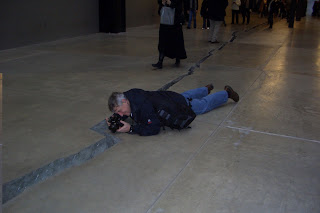A Colombian artist, a seemingly immeasurably deep abyss in the floor, 15 injured visitors and 4 complaints about the Tate Gallery; all in the first seven weeks of the most recent installation in the Turbine Hall at Tate Modern.
 Every year, the prestigious London art gallery chooses an artist to create an installation in the vast space of its ground floor Turbine Hall. In recent years giant spiders, a mystical rising sun and giant slides have astonished visitors. This year, it’s a hole! Or rather a chasm in the floor, 550 feet long, a foot wide in places and of unknown depth.
Every year, the prestigious London art gallery chooses an artist to create an installation in the vast space of its ground floor Turbine Hall. In recent years giant spiders, a mystical rising sun and giant slides have astonished visitors. This year, it’s a hole! Or rather a chasm in the floor, 550 feet long, a foot wide in places and of unknown depth.It all starts very innocently on the eastern side of the hall with a tiny hairline fissure in the floor which, at first winding and threadlike, soon increases dramatically in size and depth, at times branching off into lightning-like offshoots, before disappearing again on the other side of the hall; like a crevasse gaping dangerously in the earth’s surface. Everything appears perfectly organic and naturally, and the illusion that only moments ago an immense tremor shook the structure of the mighty building and split open the floor is perfect, as the contours of the right hand side of the crack closely follow those on the left, in essence creating two complementary ‘positive’ and ‘negative’ areas; a convex side and a concave side respectively. The longer this perfectly formed fissure is observed, the more questions come to mind, inevitably leading to the impression that it would have been impossi
 ble to create something like this artificially, and to the illusory belief that one has in fact, just been witness to the effects of real and devastating passing seismic activity in the interior of the Tate gallery. How the artwork was actually created remains shrouded in secrecy.
ble to create something like this artificially, and to the illusory belief that one has in fact, just been witness to the effects of real and devastating passing seismic activity in the interior of the Tate gallery. How the artwork was actually created remains shrouded in secrecy.The exhibited artwork carries the unusual name ‘Shibboleth’ and its creator is sculptor Doris Salcedo from Bogotá (born ibid. in 1958). Salcedo is not only the first non-European or North American artist to be invited to exhibit an installation at the Tate, but as opposed to previous installations, her work also carries a strong political message. The name ‘Shibboleth’ (or password) alludes to the Old Testament story from the book of Judges, where enemies were revealed by their inability to pronounce the word ‘shibboleth’. Those unable to articulate the term correctly due to differences in dialect were executed.
 Therefore Salcedo brings to our attention that similar discriminatory practices continue in today’s society. The West is eager to present its period of racism and colonisation as ancient history, yet in our nominally ‘post-colonial’ age, those who are not of the ‘chosen people’ still experience this as a harsh reality. If you don’t speak the required ‘passwords’ with the correct pronunciation, some doors will remain forever closed to you, and naïve attempts to cross to the other side will leave you in a bottomless crevasse.
Therefore Salcedo brings to our attention that similar discriminatory practices continue in today’s society. The West is eager to present its period of racism and colonisation as ancient history, yet in our nominally ‘post-colonial’ age, those who are not of the ‘chosen people’ still experience this as a harsh reality. If you don’t speak the required ‘passwords’ with the correct pronunciation, some doors will remain forever closed to you, and naïve attempts to cross to the other side will leave you in a bottomless crevasse.London is Europe’s most cosmopolitan metropolis, and this immediately begs the question as to whether the artist’s message is well placed here. Indeed it doesn’t seem to be at first sight, yet as with the barely visible hairline crack with which the artwork begins, the more one investigates and the longer one tarries in London and gets acquainted with the rhythms of the city, the more this gap widens and the deeper it seems to grow. The divide no longer merely consists of nationality or accent; factors such as where one lives, goes shopping, or spends one’s leisure time, all play a subtle but fundamentally divisive role. People living in the wealthy areas of West London rarely venture to the East End and vice versa. These are in many ways distinct communities, small islands separated by a great chasm.

Salcedo’s work is very visually powerful, and carries a strong social message. I remain a little concerned however as to whether the visitors’ attentions are not overly occupied with discovering the origin of the apparent seismological wonder or with the anxiety of avoiding damage to their expensive footwear to give much thought to any questions of class inequalities in their society. Perhaps at least those who were injured gave the work some thought, enough at any rate to have got themselves lodged in it. Paradoxically though this does not seem to have brought them to any greater altruism, but rather to lodging complaints about the gallery.
Turbine Hall, Tate Modern; 9 October 2007 - 6 April 2008
Published in Art & Antiques, January 2008 (http://www.artantiques.cz/)
Photo: Tomas Rabl, Veronika Wolf
Photo: Tomas Rabl, Veronika Wolf
